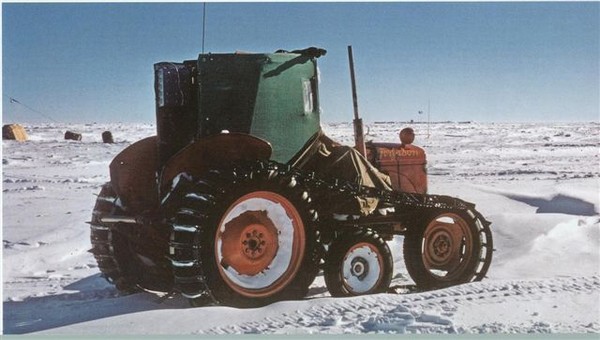New addition to Sir Edmund Hillary collection at Mount Cook museum
Thursday 10 December 2009, 2:50PM
By Southern PR
1,479 views
It’s taken more than a year of elbow grease and some Kiwi ingenuity but a new reminder of Sir Edmund Hillary was finally unveiled at Aoraki Mount Cook last night (9 December).
An exact replica of one of the legendary Ferguson TEA tractors which transported Sir Edmund and his team on their epic journey to the South Pole in 1958 has been made especially for the Sir Edmund Hillary Alpine Centre.
The tractor construction was undertaken by John Callesen, a well-known vintage car restorer and ex-All Black. He’s also the brother of Denis Callesen, who led the Sir Edmund Hillary Alpine Centre development.
John Callesen painstakingly compared hundreds of photos of the three tractors that went on the Antarctica expedition to ensure accuracy.
Photos were sourced from the Sir Edmund Hillary Alpine Centre’s existing collection while others were taken of the original tractors housed at the Canterbury Museum, MOTAT (Museum of Transport and Technology) in Auckland, and the Massey Ferguson Museum in France.
Based on the photo comparisons, John Callesen replicated every single visible part of the tractor in his Palmerston North workshop.
The tractors that went to Antarctica as part of the 1957-1958 Commonwealth Trans-Antarctic Expedition were originally to be used to help unload the Endeavour and build Scott Base. However Sir Edmund Hillary was so impressed with them that most of the huskies, which had been trained at Aoraki Mount Cook and brought over for the expedition, were replaced by the tractors.
His gamble paid off as his team went on to become the first to reach the Pole overland since Captain Robert Falcon Scott in 1912 and the first ever to do so using motor vehicles. It took the ‘tractor train’ of three tractors, a Weasel, caboose and six sledges more than 80 days to complete the 1,930km (1,200-mile) journey.
Many modifications were made to the tractors before departure but, lacking a local hardware store, the team was forced to get creative with the materials on hand at Scott Base. Consequently, the likes of Dexion shelving and Waratah fencing standards became invaluable in ensuring the tractors survived the journey to the Pole.
John Callesen says his biggest hurdle in building the tractor was distinguishing between the numerous alterations made to the tractors before and after their trip to the Pole.
"The tractors stayed at the South Pole for several years afterwards and were further modified which made producing an exact visible replica tricky. However, based on original photos and feedback from surviving expedition members, what I’ve built looks exactly like what the expedition team drove to the Pole, gas torch scorch marks and all,” he says.
The replica tractor now sits in the dedicated Sir Edmund Hillary Gallery alongside items such as 50-year old footage of Sir Edmund boarding the Endeavour, the original mileage wheel showing the exact distance to the Pole, and Sir Edmund’s original primus stove. There’s also imagery of Sir Edmund training at Aoraki Mount Cook in 1957 on what’s believed to be one of the tractors that went to Antarctica.
Denis Callesen, General Manager of Tourism for Aoraki Mount Cook Alpine Village Ltd, is delighted with the replica tractor, saying it adds to the picture they’re building of Sir Edmund’s life and his Himalayan and Antarctic training links to Aoraki Mount Cook.
“It’s an honour to be able to share Sir Ed’s intriguing story with the world and we’re very grateful to those who contribute items which help put things in context for our visitors. Seeing the primitive equipment he and his various expedition parties used gives people a sense of the triumphs, tribulations and magnitude of what they achieved. Imagine battling Antarctica’s extreme cold and crevasses on ordinary farm tractors without the technology or equipment we have today - it’s a truly amazing feat.”
The Sir Edmund Hillary Alpine Centre was officially opened on 29 May 2008 by Sir Edmund’s widow, June, Lady Hillary Q.S.M. It is located adjacent to The Hermitage Hotel in Aoraki Mount Cook Alpine Village, within the Aoraki Mount Cook National Park and World Heritage area. The Village is a spectacular 55km drive from the Lake Pukaki / State Highway 8 turn-off and is four hours from Christchurch (272km) and three hours from Queenstown (330km).
For more information please visit www.hillarycentre.co.nz.
More information about the Antarctic Expedition
The New Zealand arm of the Commonwealth Trans Antarctic Expedition (TAE) was in the Antarctic from 1956 to 1958 - although planning began several years earlier, and reconnaissance was done in the summer of 1955-56.
The New Zealand team for the South Pole left Scott Base on 14 October 1957, and arrived at the Pole on 4 January 1958.
Although there were two or three ‘relief drivers’ early on, the team that made the final push for the Pole was Sir Edmund Hillary, Peter Mulgrew, expedition mechanics Murray Ellis and Jim Bates, and cinemagrapher Derek Wright.
Using the Fergusons instead of teams of huskies freed up these teams to explore, map and do geological surveys of a vast area which had never before done. They accomplished one of the last great ‘foot’ surveys of the Antarctic.
